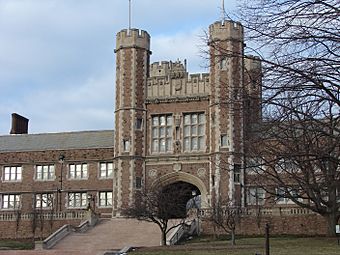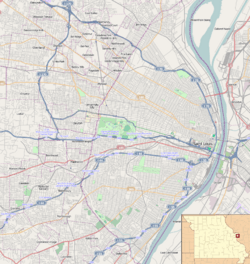Washington University Hilltop Campus Historic District facts for kids
|
Washington University Hilltop Campus Historic District
|
|
 |
|
| Location | St. Louis, Missouri |
|---|---|
| Built | 1900 |
| Architect | Jamieson & Spearl |
| Architectural style | Late Gothic Revival |
| NRHP reference No. | 79003636 |
Quick facts for kids Significant dates |
|
| Added to NRHP | January 12, 1979 |
| Designated NHLD | February 27, 1987 |
The Washington University Hilltop Campus Historic District is a special area in St. Louis, Missouri. It was once the location for two very important events in history. These were the Louisiana Purchase Exposition in 1904 and the 1904 Summer Olympics.
Many buildings for the Exposition were only meant to be temporary. However, some permanent structures were also built. These buildings are now used by Washington University. The university calls this area its Danforth Campus. The district has over fifty buildings. About twenty of them are built in a style called Collegiate Gothic.
Contents
Designing the Washington University Campus
The overall plan for the Washington University campus was created in 1895. A famous group of landscape architects, Olmsted, Olmsted and Eliot, designed it. In 1899, a national competition was held. This competition was to choose the best design for the new university buildings.
A firm named Cope and Stevenson from Philadelphia won the competition. They had experience from designing buildings at other universities. These included Bryn Mawr College, the University of Pennsylvania, and Princeton University.
How the World's Fair Helped Build the Campus
As construction of the university began, plans for the Louisiana Purchase Exposition also started. The fair organizers decided to use the new university buildings. They leased the campus for the fair. This also provided money to build even more university buildings.
What is Collegiate Gothic Style?
The buildings on campus are built in the Collegiate Gothic style. They look like they all belong together, even though they were built over fifty years. This is because of a special style guide. Architect James P. Jamieson created this guide.
His guide explained exactly how to use certain materials. These included red granite, green slate shingles, and copper details. Windows were set into limestone frames. Buildings were often placed around a central open area called a quadrangle. The parts of the buildings facing the quadrangle were two stories tall. The back parts were three stories. Many buildings also followed a standard "H" shape. They often had a central tower that was three to five stories high.
Important University Buildings
Many buildings on the campus were used during the 1904 World's Fair. They later became important parts of Washington University.
- Brookings Hall (1900): This is a key landmark on the campus. It was used as the main administration building for the Exposition.
- Busch Hall (1900): This building housed the fair's "Division of Works." This included the architects, engineers, and construction managers.
- Ridgley Library (1901): The British Government used this building. They displayed items from Queen Victoria's Diamond Jubilee here.
- Eads Hall (1902): This building was used by the "Board of Lady Managers." This group helped organize parts of the fair.
- Cupples Hall I (1901): This building was used for anthropology exhibits. It even had mummies in the basement!
- Cupples Hall II (1901): This building was home to the Jefferson Guard. This was the fair's security team.
- Prince Hall (1901): Another building used by the university.
- Karl D. Umrath Hall (1902): This building served as a dormitory for guests visiting the fair.
- Francis Gymnasium (1902) and Francis Field (1902-1903): These were used for physical culture displays. They also hosted the Third Olympic Games in 1904.
Later Additions to the Campus
After the World's Fair, more buildings were added to the campus. They were designed to match the original Collegiate Gothic style. Some of these include:
- McMillan Hall (1906)
- Graham Chapel (1907)
- Newton R. Wilson Memorial Hall (1923)
- Duncker Hall (1923)
- Grace Vallé January Hall (1923)
- Charles Rebstock Hall (1926)
- The Ann W. Olin Women's Building (1927)
- Wayman Crow Hall (1933)
- George Warren Brown Memorial Hall (1935)
- The Sever Institute of Technology (1948)
- Louderman Hall (1951)
Other Important Buildings from the Exposition
Some other buildings were built for the 1904 Exposition. They are still important landmarks in St. Louis today.
- The Palace of Fine Art: This building was designed by architect Cass Gilbert. It had a huge indoor sculpture court. This court was inspired by the ancient Roman Baths of Caracalla. The Palace of Fine Art stands at the top of Art Hill. It is now the home of the St. Louis Art Museum.
- The Missouri State Building: This building was planned to be permanent. However, it burned down on November 18, 1904. The fair was almost over, so it was not rebuilt. After the fair, the World's Fair Pavilion was built on the same spot.
- The Jefferson Memorial Building: This building was finished in 1913. It was built near the main entrance to the Exposition. Money from the fair helped build it. It was built to honor Thomas Jefferson. He was the president who started the Louisiana Purchase. The building also stored all the records and archives from the Exposition. It is now home to the Missouri History Museum.
Images for kids





